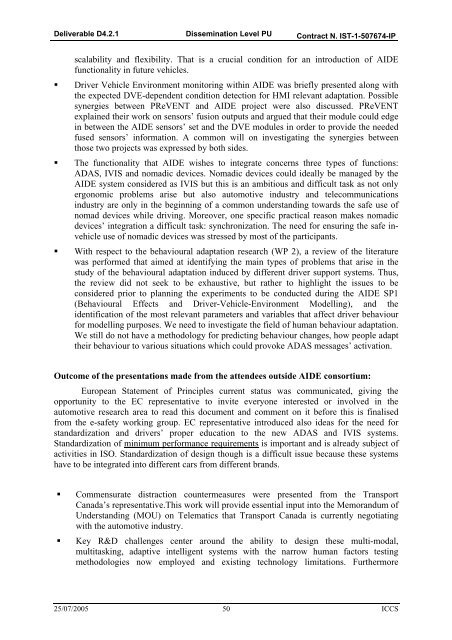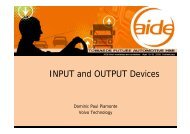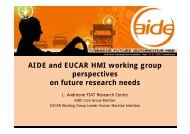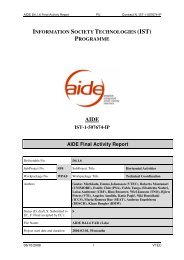download deliverable - AIDE
download deliverable - AIDE
download deliverable - AIDE
You also want an ePaper? Increase the reach of your titles
YUMPU automatically turns print PDFs into web optimized ePapers that Google loves.
Deliverable D4.2.1 Dissemination Level PU Contract N. IST-1-507674-IP<br />
scalability and flexibility. That is a crucial condition for an introduction of <strong>AIDE</strong><br />
functionality in future vehicles.<br />
• Driver Vehicle Environment monitoring within <strong>AIDE</strong> was briefly presented along with<br />
the expected DVE-dependent condition detection for HMI relevant adaptation. Possible<br />
synergies between PReVENT and <strong>AIDE</strong> project were also discussed. PReVENT<br />
explained their work on sensors’ fusion outputs and argued that their module could edge<br />
in between the <strong>AIDE</strong> sensors’ set and the DVE modules in order to provide the needed<br />
fused sensors’ information. A common will on investigating the synergies between<br />
those two projects was expressed by both sides.<br />
• The functionality that <strong>AIDE</strong> wishes to integrate concerns three types of functions:<br />
ADAS, IVIS and nomadic devices. Nomadic devices could ideally be managed by the<br />
<strong>AIDE</strong> system considered as IVIS but this is an ambitious and difficult task as not only<br />
ergonomic problems arise but also automotive industry and telecommunications<br />
industry are only in the beginning of a common understanding towards the safe use of<br />
nomad devices while driving. Moreover, one specific practical reason makes nomadic<br />
devices’ integration a difficult task: synchronization. The need for ensuring the safe invehicle<br />
use of nomadic devices was stressed by most of the participants.<br />
• With respect to the behavioural adaptation research (WP 2), a review of the literature<br />
was performed that aimed at identifying the main types of problems that arise in the<br />
study of the behavioural adaptation induced by different driver support systems. Thus,<br />
the review did not seek to be exhaustive, but rather to highlight the issues to be<br />
considered prior to planning the experiments to be conducted during the <strong>AIDE</strong> SP1<br />
(Behavioural Effects and Driver-Vehicle-Environment Modelling), and the<br />
identification of the most relevant parameters and variables that affect driver behaviour<br />
for modelling purposes. We need to investigate the field of human behaviour adaptation.<br />
We still do not have a methodology for predicting behaviour changes, how people adapt<br />
their behaviour to various situations which could provoke ADAS messages’ activation.<br />
Outcome of the presentations made from the attendees outside <strong>AIDE</strong> consortium:<br />
European Statement of Principles current status was communicated, giving the<br />
opportunity to the EC representative to invite everyone interested or involved in the<br />
automotive research area to read this document and comment on it before this is finalised<br />
from the e-safety working group. EC representative introduced also ideas for the need for<br />
standardization and drivers’ proper education to the new ADAS and IVIS systems.<br />
Standardization of minimum performance requirements is important and is already subject of<br />
activities in ISO. Standardization of design though is a difficult issue because these systems<br />
have to be integrated into different cars from different brands.<br />
• Commensurate distraction countermeasures were presented from the Transport<br />
Canada’s representative.This work will provide essential input into the Memorandum of<br />
Understanding (MOU) on Telematics that Transport Canada is currently negotiating<br />
with the automotive industry.<br />
• Key R&D challenges center around the ability to design these multi-modal,<br />
multitasking, adaptive intelligent systems with the narrow human factors testing<br />
methodologies now employed and existing technology limitations. Furthermore<br />
25/07/2005 50 ICCS







